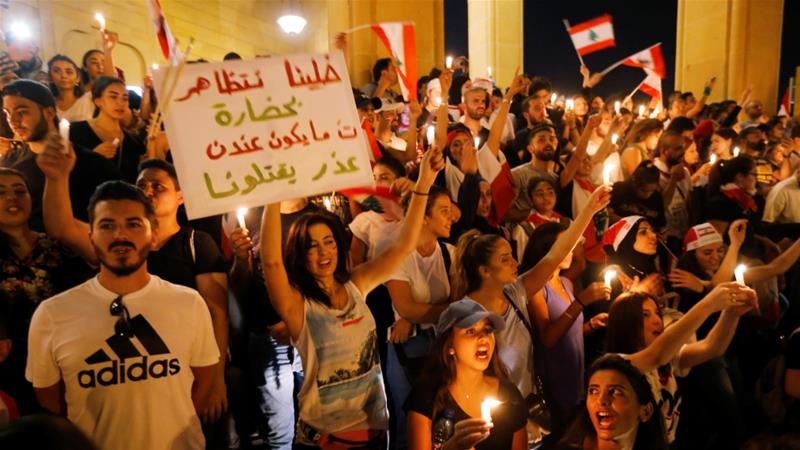Revolutions are hardly ever associated with non-violence, especially when they intend to overthrow an authoritarian system. The forces in power will often use violence, through law enforcement or politically-affiliated thugs to suppress the voice of protesters. Reciprocation can lead to loss of life, and can sometimes escalate into civil war. For this reason, the Lebanese revolution must remain peaceful.
The October revolution in Lebanon is characterised by its non-violent approach. Protesters have chosen to sing, dance, bang on pots and pans, take over public spaces and block roads. This type of resistance does not threaten anyone’s safety and is thus legitimately non-violent.
Some arguments against road closure bring up the ‘right to free movement’. They call it a form of violence, citing their desire to go to work and move freely around the country. Road closure is accused of being oppressive, and of being a painful reminder of the civil war. This unfairly tarnishes the peaceful nature of this form of protest.
The UN Rapporteur of Freedom of Peaceful Assembly and Association outright states that “the free flow of traffic should not automatically take precedence over the freedom of peaceful assembly.” As long as a roadblock is peaceful and does not block access to hospitals, it is legitimate and is within the rights of protesters.
However, roadblocks are causing divisions between demonstrators, and so should be forgone as a means of protest.
Aside from roadblocks, physical violence in places of demonstration is another source of division. Whenever a fight breaks out, or individuals vandalise private and public properties, it tarnishes the image of the revolution and creates discourse against the protesters, criticising their violent behavior.
Peaceful, independent demonstrations in Lebanon have historically been infiltrated by supporters of different sects who erode the fundamental foundation of these protests by acting violently against state forces. This gives authorities a basis to push back against the protesters, frame them as a source of chaos, and undermine any message they attempt to get across.
The 2019 October revolution is an uprising against the whole political and social structure in Lebanon. While it seemed at first as though protesters agreed on their demands, it gradually became clear that there are plenty of internal inconsistencies.
A lot of demonstrators eventually showed their true affiliations, calling for an overthrow of all sects except their own. They came out as being pro-revolution, while still supporting their confessional parties and leaders.
These factions are inciting the most violence, and causing a larger divide between the people. When thugs act violently, and protesters reciprocate, this creates an ideal narrative for the sectarian leaders. Leaders are given the chance to victimize themselves, framing the protests as a form of persecution. The revolution is then accused of being a ruse by their rival parties. This both furthers sectarian loyalty and worsens sectarian tensions.
When a group of extremely devoted followers feel like their faith is being attacked, the instinctive human reaction is to come to the defense of this faith. History has taught us that confrontation can’t change a group’s belief.
Coercion only amplifies faith.
By calling followers “sheep,” insulting their leaders and acting violently against them, they disconnect from the message of the revolution and become ardent opposers. To win over the remaining factions still loyal to their Zu’ama, the revolution needs to maintain a moral high ground. When the army acts violently, protesters should stand their ground without fighting back. When thugs provoke and beat protesters, they should turn the other cheek.
This will both smear the image of the perpetrators and sects, and incite empathy for the protesters and their message. The media will advertise the non-violent aspect of the revolution, the aggressors will be viewed in a bad light and confessional leaders will have less content to support their anti-revolution discourse.
A recent confrontation on the Ring Bridge is a good case to study sectarian violence and how anti-sectarian revolutionaries should behave. Hezbollah and Amal thugs clashed with protesters blocking the road. While the protesters claim to be revolutionaries, there is viable suspicion that amongst them were supporters of other political parties inciting violence against their sectarian opposition.
When clashes occurred, groups of protesters acted uncharacteristically violent. They hit and insulted Hezbollah and Amal supporters instead of choosing the non-violent route. These pro-revolution thugs will harm the revolution’s cause. Their acts will push away Hezbollah and Amal supporters who could have been swayed to join the revolution.
Meanwhile, honest anti-sectarian revolutionaries took a different stance while Hezbollah and Amal supporters assaulted them. Instead of confronting them with violence, they began chanting in support of Dahieh, Sour, Nabatieh and Baalbek –-predominantly Shiite areas.
This approach of trying to win over, rather than oppose those yet to be convinced, is certainly more likely to yield positive results.
For that to succeed, the revolution needs to create a contrast between itself and any sectarian violence. Protesters need to voice their segregation from sects that are siding with the revolution for their own benefit and violently confronting their opposition. They must disconnect themselves from any acts of violence, and allow sectarian thugs to destroy each other’s image in the public eye.
Protesters essentially must remain as impartial and unprovocative as possible, making it clear that any allusion to the civil war is coming from the sects themselves. This way, there is a better chance of swaying those yet to be convinced and showing that this revolution is, indiscriminately, a step in the right direction.
See also: Manakeesh in Zaytounay? How protesters are reclaiming public spaces in Lebanon
